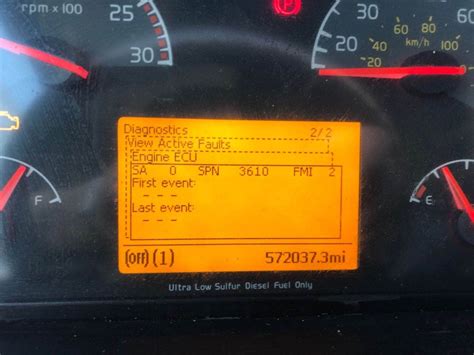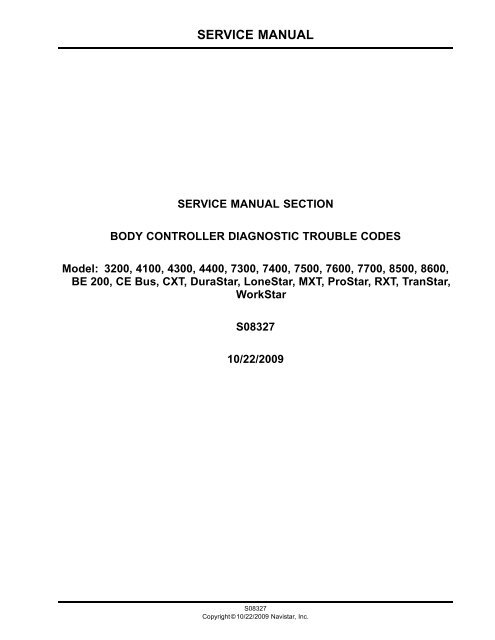The Code SPN 101 FMI 16 refers to an issue with the engine fuel delivery system. This fault code indicates a problem with the fuel pressure sensor or the related components.
It is essential to address this issue promptly to ensure proper engine performance and prevent further damage. Having a clear understanding of any error codes that appear on your vehicle’s diagnostic system is crucial for maintaining its optimal performance. One such code is the Code SPN 101 FMI 16, which points to a specific problem related to the fuel delivery system in the engine.
By decoding this fault code, mechanics can identify issues with the fuel pressure sensor or its associated components. Addressing this concern promptly ensures that the engine functions efficiently and helps prevent potentially costly damages. We will delve deeper into the intricacies of Code SPN 101 FMI 16, providing insights into its meaning and its significance for vehicle owners and technicians alike.

Credit: my-dear-fellow-calimero-the-angel.de
Understanding Spn And Fmi Codes
Understanding SPN and FMI codes is essential when it comes to troubleshooting vehicle issues. Discovering the meaning of code SPN 101 FMI 16 can help diagnose and fix the problem efficiently.
What Are Spn And Fmi Codes?
SPN (Suspect Parameter Number) and FMI (Failure Mode Identifier) codes are diagnostic trouble codes (DTCs) used in the realm of vehicle diagnostics. These codes provide crucial information about specific issues or malfunctions that occur in the vehicle’s various systems. Understanding these codes is essential for effective troubleshooting and accurate diagnosis.
Importance Of Spn And Fmi Codes In Diagnostics
SPN and FMI codes play a vital role in diagnostic procedures, assisting technicians in pinpointing the root cause of a problem. Here’s why these codes are crucial:
- Efficient Troubleshooting: SPN codes indicate the general category or system where the fault is occurring, such as engine, transmission, or brakes. On the other hand, FMI codes provide additional details about the specific failure mode within that category. By having access to these codes, technicians can quickly narrow down their troubleshooting efforts to the relevant system, saving time and effort.
- Precision Diagnosis: SPN and FMI codes offer specific information about the nature of the fault or malfunction, allowing technicians to identify and understand the exact issue affecting the vehicle. This precision enables accurate diagnosis, preventing misdiagnosis and unnecessary repairs, ultimately saving both time and money.
- Effective Communication: SPN and FMI codes create a standardized language for diagnostic purposes across different makes and models of vehicles. When technicians encounter these codes, they can easily share the information with colleagues or refer to troubleshooting manuals and databases, enhancing communication and collaboration within the automotive industry.
- Enhanced Vehicle Performance: Resolving issues promptly and accurately through SPN and FMI codes can ensure optimal vehicle performance. By addressing identified faults, technicians can restore the vehicle to its intended functionality, improving reliability, safety, and overall customer satisfaction.
- Preventive Maintenance: SPN and FMI codes aren’t just used for troubleshooting existing problems. They can also be utilized in preventive maintenance by monitoring specific parameters and identifying potential issues before they escalate. This proactive approach helps prevent breakdowns, prolongs the lifespan of the vehicle, and reduces the risk of costly repairs.
In conclusion, SPN and FMI codes are valuable tools in automotive diagnostics. They provide important information that aids technicians in troubleshooting, diagnosing, and resolving issues efficiently, leading to improved vehicle performance and customer satisfaction. Familiarity with these codes is crucial for professionals in the automotive industry and anyone involved in vehicle maintenance and repair.
Common Causes Of Code Spn 101 Fmi 16
Code SPN 101 FMI 16 is commonly encountered in different devices and equipment, and it indicates a fault with the inlet air temperature sensor. This code can be found in various systems, such as diesel engines and HVAC systems, where the inlet air temperature plays a crucial role in performance and efficiency. Understanding the common causes behind this code can help in diagnosing and resolving the issue effectively.
Overview Of Code Spn 101 Fmi 16
Code SPN 101 FMI 16 refers to a fault related to the inlet air temperature sensor. This sensor is responsible for measuring the temperature of the incoming air, which is crucial for correct fuel delivery, engine timing, and overall performance. The code is triggered when the sensor detects an abnormal reading or discontinuity in the signal it sends to the electronic control module (ECM).
Typical Malfunctions Leading To Spn 101 Fmi 16
There are several common malfunctions that can lead to the occurrence of code SPN 101 FMI 16:
- 1. Faulty or Damaged Sensor: A common cause of this code is a faulty or damaged inlet air temperature sensor. Over time, these sensors can become worn out or suffer from electrical issues, leading to abnormal temperature readings or signal disruptions.
- 2. Wiring or Connector Problems: In some cases, the wiring or connectors associated with the inlet air temperature sensor may become loose, corroded, or damaged. This can interfere with the signal transmission and trigger the code SPN 101 FMI 16.
- 3. Intake Air Restriction: An excessive intake air restriction can cause the sensor to register incorrect temperature readings. This can happen due to a clogged air filter, obstructions in the intake system, or even a faulty turbocharger.
- 4. Engine Overheating: If the engine is experiencing overheating issues, it can impact the temperature readings from the inlet air. The elevated temperatures can trigger code SPN 101 FMI 16, indicating a fault in the sensor or the surrounding components.
Identifying the precise cause behind SPN 101 FMI 16 is essential for effective troubleshooting and resolving the issue. By examining the sensor, its wiring, and considering possible constraints on the intake air, you can pinpoint the problematic area and take suitable corrective measures.
Troubleshooting Steps
When encountering Code SPN 101 FMI 16, following specific troubleshooting steps is crucial to identify and resolve the issue promptly.
Initial Inspection And Assessment
- Begin by visually inspecting all components related to the fault code.
- Check for any loose connections, damaged wires, or leaking fluids.
- Assess the immediate environment for any signs of wear or tear.
Identifying Potential Culprits
- Focus on potential sources creating the issue.
- Pinpoint components that are likely causing the fault code.
- Analyze past maintenance records for clues.
Diagnostic Tools And Techniques
- Use advanced diagnostic tools for accurate detection.
- Conduct thorough testing procedures methodically.
- Refer to the vehicle’s manual for specific diagnostic guidelines.

Credit: www.yumpu.com
Understanding Diagnostic Codes
Get insights into diagnostic codes with SPN 101 FMI 16, which provide specific information for troubleshooting. Understanding these codes aids in pinpointing issues for efficient resolution and maintenance. Decode SPN 101 FMI 16 to enhance troubleshooting capabilities and eliminate potential problems swiftly.
Understanding Diagnostic Codes Diagnostic codes play a crucial role in identifying and resolving issues within a vehicle’s onboard systems. Interpreting SPN 101 and FMI 16 codes allows technicians to pinpoint specific malfunctions, leading to effective troubleshooting and repair. Linking these codes to specific issues provides valuable insights into the health of the vehicle, ensuring safe and efficient operation. Interpreting SPN 101 and FMI 16 Codes The SPN 101 code typically signifies a fault in the engine’s speed sensor, indicating potential issues with the vehicle’s performance. On the other hand, FMI 16 points to a high voltage situation, warranting prompt attention to prevent further damage. Understanding the implications of these codes is essential for diagnosing and addressing underlying problems accurately. Linking Codes to Specific Issues By associating SPN 101 and FMI 16 codes with their respective meanings, technicians can swiftly identify the root cause of the malfunction. This direct correlation bridges the gap between the diagnostic codes and the actual issues, streamlining the repair process and minimizing downtime for vehicle owners. It empowers technicians to take targeted actions and implement effective solutions, ensuring optimal functionality and safety for the vehicle. In conclusion, understanding diagnostic codes such as SPN 101 and FMI 16 is integral to the maintenance and upkeep of vehicles, guiding technicians in diagnosing and resolving specific issues efficiently.Effective Resolutions
When dealing with the diagnostic code SPN 101 FMI 16, it is essential to focus on effective resolutions to address the underlying issues and ensure seamless operation of the system. By implementing corrective actions and addressing common problems, you can effectively resolve the code SPN 101 FMI 16 and prevent potential reoccurrences.
Addressing Common Problems
Understanding and identifying common problems associated with the diagnostic code SPN 101 FMI 16 is crucial for effective resolution. Some common issues include faulty sensors, wiring issues, or system malfunctions. By conducting a thorough diagnostic assessment, you can pinpoint the specific problem areas and take proactive measures to address them.
Implementing Corrective Actions
- Check and replace faulty sensors or components.
- Thoroughly inspect and repair any damaged wiring.
- Ensure proper calibration and alignment of the system.
- Update firmware or software to the latest version.
Implementing these corrective actions can effectively resolve the diagnostic code SPN 101 FMI 16, restoring the system’s functionality and preventing potential issues in the future.

Credit: otrperformance.com
Professional Tips And Best Practices
Discover essential Professional Tips and Best Practices for handling Code SPN 101 FMI 16 effectively.
Proactive Maintenance Strategies
- Regularly inspect vehicle diagnostics systems to detect potential issues early.
- Implement a preventative maintenance schedule to ensure optimal performance.
- Invest in quality diagnostic tools for accurate troubleshooting.
Training Recommendations For Technicians
- Provide comprehensive training programs on Code SPN 101 FMI 16 specifics.
- Encourage technicians to stay updated on the latest diagnostic techniques.
- Offer hands-on workshops and simulations for practical experience.
Preventive Maintenance
When it comes to Code Spn 101 Fmi 16, preventive maintenance plays a crucial role in avoiding unnecessary downtime and costly repairs. Regular checks and preventive measures can help ensure the smooth functioning of your equipment and prevent any potential issues.
Importance Of Regular Checks
Regular checks are essential to identify any early signs of trouble and avoid expensive repairs in the future. By conducting regular inspections and maintenance, you can detect any problems before they worsen and potentially cause equipment failure.
Some key benefits of regular checks include:
- Increasing the lifespan of your equipment
- Improving safety for you and your team
- Reducing the risk of breakdowns and downtime
- Enhancing the overall performance and efficiency of your equipment
Preventive Measures For Avoiding Spn 101 Fmi 16
To avoid encountering SPN 101 FMI 16, there are several preventive measures you can take:
- Implementing a regular maintenance schedule: Set up a routine maintenance plan to ensure that your equipment is regularly checked, serviced, and repaired if necessary. This will help catch any potential issues before they escalate.
- Monitoring fluid levels: Keep a close eye on fluid levels, such as oil and coolant, and make sure they are at the appropriate levels. Low levels can lead to overheating and other problems.
- Cleaning and inspecting filters: Clean and inspect filters regularly to prevent dirt and debris from clogging the system. Clogged filters can lead to reduced performance and even engine damage.
- Checking for leaks: Inspect your equipment for any signs of leaks, such as fluid puddles or unusual smells. Addressing leaks promptly can prevent further damage and ensure the proper functioning of your equipment.
By following these preventive measures, you can significantly reduce the chances of encountering SPN 101 FMI 16 and ensure the smooth operation of your equipment.
Frequently Asked Questions Of Code Spn 101 Fmi 16
What Is The Meaning Of Code Spn 101 Fmi 16?
Code SPN 101 FMI 16 is an indication of an open circuit in the engine’s fuel control system. It signifies a potential issue with the fuel delivery system and requires immediate attention to prevent engine malfunctions.
How Do I Diagnose Code Spn 101 Fmi 16?
To diagnose Code SPN 101 FMI 16, conduct a thorough inspection of the fuel control system, including the fuel lines, filters, and injectors. Use diagnostic tools to identify the specific location of the open circuit and address the issue promptly to ensure optimal engine performance.
What Are The Potential Causes Of Code Spn 101 Fmi 16?
Code SPN 101 FMI 16 can be triggered by various factors, such as damaged wiring, faulty fuel injectors, or issues with the fuel pump. It’s crucial to investigate each potential cause meticulously to pinpoint the root issue and implement the necessary repairs for reliable engine operation.
Conclusion
Understanding Code SPN 101 FMI 16 is crucial for efficient troubleshooting. By applying the correct diagnostic steps, errors can be quickly identified and rectified in the system. With this knowledge, you can enhance the performance and reliability of your equipment, ensuring smooth operations and minimizing downtime.
Mastering this code empowers you to handle challenges effectively in the field.